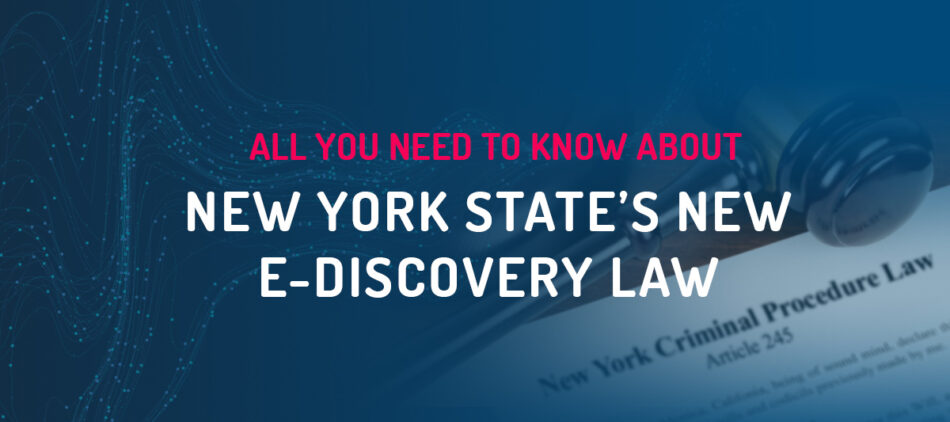
All you need to know about New York State’s new e-discovery law
Technology Solutions that Accelerate the Discovery Process
New York State’s new e-discovery law puts time pressure on prosecutors
They say justice is blind. However, a recently passed New York state law promises to remove the blindfolds from defense lawyers by mandating that prosecutors submit all evidence against defendants at the earliest possible stages of a case. Because the law affects audio and video-based evidence too, prosecutors will need to accelerate the multimedia discovery process, requiring the adoption of artificial intelligence (AI) tools that allow rapid e-discovery during the early case assessment (ECA) stage of cases.
New York State joins the early discovery parade
The new law, which goes into effect in January 2020, mandates that a wide range of information be turned over within 15 days after an arraignment. New York’s current law requires prosecutors to submit information like video footage to defense teams only upon request. However, proponents of the new legislation claim that such requests often aren’t honored.
The current law has placed defendants in legal peril, sometimes forcing them to enter pleas with no awareness of the evidence against them. In fact, despite its liberal reputation, New York is regarded to have one of the most pro-prosecution discovery laws in the nation, rivaling policies in conservative states like Wyoming, Louisiana and South Carolina. Opponents have labelled the New York rules as “blindfold laws,” which force defendants to make critical decisions before being aware of the nature of the evidence against them.
However, New York has joined a slew of other states that have enhanced disclosure laws during the past decade. For example, Ohio in 2010 adopted a new criminal rule that compels the government to turn over all material evidence to the defense. Meanwhile, New Jersey and Utah have adopted rules requiring discovery to be provided before a guilty plea is entered.
The passage of the new law takes “New York from being dead last in discovery openness to being in the vanguard nationally,” said Jennifer Laurin, a University of Texas law professor quoted by the Marshall Project. As a result, other states could potentially follow New York’s lead in the future, creating new disclosure burdens for prosecutors around the country.
The expansion of ECA
For prosecutors, this trend is shifting parts of the discovery process to earlier in the case. To rapidly surface critical information that’s stored in evidence, legal teams employ Early Case Assessment (ECA), a type of discovery conducted during the early phases of a case. Legal teams commonly engage in ECA as a form of triage, using the process to help deciding which cases to pursue, and which to drop.
However, with the time constraints imposed by the New York law, the scope of ECA may expand to include other aspects of discovery, including uncovering evidence that must be disclosed to the defense early in the case.
AI in the era of rapid discovery
While this sounds simple enough, the ECA process presents major challenges when it comes to the discovery of audio and video evidence. With the massive amounts of multimedia content contained within evidence, it can take enormous quantities of time and effort to search for key information that must be disclosed. With timeframes shrinking, it’s no longer practical for a lawyer—or even an entire legal team—to sift through — or in the case of video and audio evidence, watch and listen to — all the available information manually. Luckily, the arrival of cloud-based AI solutions is making ECA and e-discovery practical for legal teams of all sizes.
AI is already enjoying increased acceptance throughout the eDiscovery processes. AI algorithms including speech, face, object and word recognition can automatically ingest massive quantities of text, audio and video-based evidence. And while manual processes can consume weeks or months of effort, the algorithms can complete such tasks in a matter of minutes.
The algorithms can then transform every second or frame of audio or video content into a format that can easily be searched and analyzed for words, phrases, faces, and sentiment identification. They then can take that unstructured data and produce an index, or structure, within a matter of minutes. This dramatically compresses the time and effort required for eDiscovery, allowing government legal teams to quickly complete the process and meet the time demands of laws like the new legislation in New York.
Veritone illuminates ECA
Veritone’s Illuminate platform is specifically designed to help legal teams tackle ECA challenges. With Veritone Illuminate, teams can assess audio, video and text-based evidence when they are making their initial case evaluations. This gives legal organizations greater control over time and cost.
Legal professionals can use Illuminate to quickly pinpoint, search and analyze media on the front end to focus only on relevant evidence, while leveraging best-of-breed AI engines to produce a searchable index. They then can export media assets to a desired eDiscovery or disclosure-review platform, further accelerating the process of ECA and eDiscovery.
While justice may be blind, it’s certainly not dumb. With the arrival of AI tools, the eDiscovery process is getting smarter and allowing government lawyers to meet the strict time constraints imposed by new laws like the one in New York.
To learn how Veritone is helping legal teams boost early case assessment efforts and gain actionable insights from audio, video, and text documents visit veritone.com/illuminate or watch our webinar.